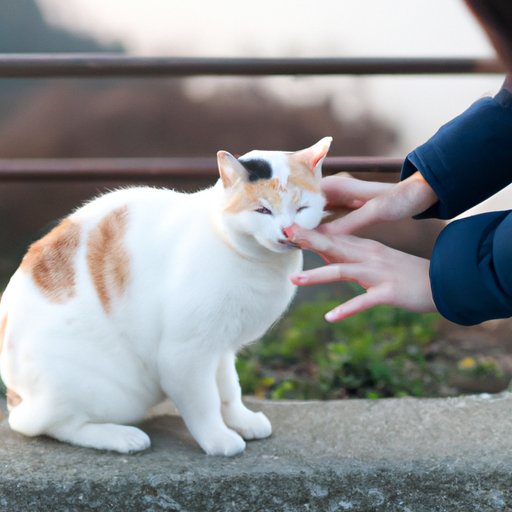Introduction
It’s a common problem for cat owners: you’re sitting on the couch, engrossed in a TV show, when suddenly your furry companion starts rubbing against your legs. While it might be adorable, it can also be frustrating if you don’t understand what your cat is trying to communicate.
In this article, we’ll explore the reasons why cats rub against their owners and what these tactile expressions might mean. We’ll delve into the science behind cat behavior, the instinctual nature of felines, and the social cues that cats convey through physical contact. By understanding your cat’s behavior and needs, you can deepen your bond and strengthen your relationship with your feline friend.
Deciphering feline affection: What your cat’s rubs really mean
Cats use rubbing as a way to communicate and mark their territory. They have scent glands on their cheeks, chin, forehead, and tail, which release pheromones when they rub against people or objects. Depending on the type of rub, your cat might be trying to assert dominance, mark its territory, or ask for attention.
When a cat rubs its head against you, it’s considered a friendly gesture. This is because the cat is depositing its scent on you, which marks you as part of its territory. Cats will often rub against familiar people, such as their owners or other cats in the household. This type of rub is a sign of affection and trust.
If your cat rubs its body against you, it might be trying to gain attention or affection. This is a form of solicitation, where the cat is asking you to pet or play with it. It’s a sure sign that your cat is in a playful or affectionate mood.
On the other hand, if your cat rubs against furniture or objects in your home, it might be trying to mark its territory. Cats have a strong instinct to establish their dominance in their environment, and rubbing against objects is a way to leave their scent and mark their territory.
The science behind cat behavior: Why your furry companion rubs against you
Understanding the science behind cat behavior can help you decipher your cat’s rubs and other forms of communication. When a cat rubs against a person or object, it’s depositing pheromones that communicate information to other cats. These pheromones can convey social status, breeding availability, and information about the cat’s emotional state.
In addition to pheromones, cats also communicate through body language and vocalizations. They use their tails, ears, and whiskers to signal their emotional state, and they use meows, purrs, and hisses to convey messages to their owners and other cats.
Exploring the bond between cats and their owners through physical contact
Physical contact is an important aspect of the relationship between cats and their owners. Tactile expressions of affection, such as petting, grooming, and playing, can deepen the bond between cats and their humans. These interactions release feel-good hormones, such as oxytocin, that promote feelings of closeness and trust.
Regular physical contact can also help mitigate stress and anxiety in cats. Cats are sensitive creatures that can get easily stressed out by changes in their environment or routine. Physical contact with their owner can provide a sense of safety and comfort that helps them feel more at ease.
Understanding the instinctual nature of cats: A guide to decoding their behavior
Cats have an instinctual nature that drives many of their behaviors, including rubbing against people and objects. This behavior evolved as a way for cats to mark their territory and establish their dominance in their environment. It’s also a way for cats to communicate with other cats and humans.
Understanding the innate behaviors of cats can help owners build a better relationship with their feline friends. By adapting our behavior and environment to meet our cat’s needs, we can help them feel more comfortable and secure in our homes.
The social significance of feline rubbing: What your cat is trying to tell you
Cat owners should pay attention to their feline friend’s nonverbal cues, such as rubbing, to better understand their needs and emotions. Rubbing can convey a variety of messages, from affection to anxiety or stress. Owners should observe their cat’s body language and vocalizations to get a better sense of what their cat is trying to communicate.
Cats are social creatures that thrive on interaction and engagement with their environment. Owners who take the time to understand their cat’s behavior and respond appropriately will have a deeper and more meaningful relationship with their feline companions.
The psychology of cat behavior: Uncovering the reasons behind your cat’s tactile expressions
Cats have individual preferences and temperaments that shape their behavior and interaction with their environment. Owners who understand their cat’s unique needs will be better equipped to provide a safe and nurturing environment that promotes their cat’s emotional well-being.
Factors that can influence a cat’s behavior include its age, breed, personality, and life experience. Owners who take the time to observe their cat’s behavior and respond empathetically will have a stronger bond with their feline friend.
Conclusion
In conclusion, cats rub against their owners as a way to communicate and mark their territory. By understanding the science behind cat behavior and the instinctual nature of felines, owners can better decipher their cat’s tactile expressions. Regular physical contact with their owner can deepen the bond between cats and humans, mitigate stress and anxiety in cats, and promote feelings of closeness and trust.
It’s important for owners to pay attention to their cat’s nonverbal cues and respond empathetically to their needs. By doing so, they can build a stronger, more meaningful, and more fulfilling relationship with their feline companion.
